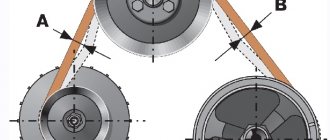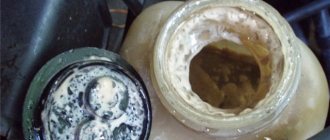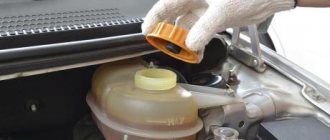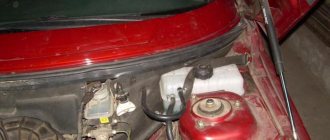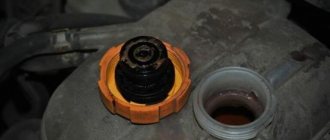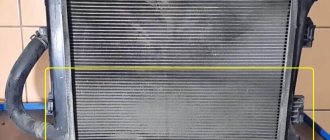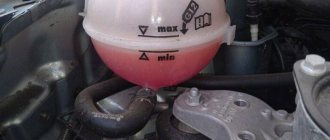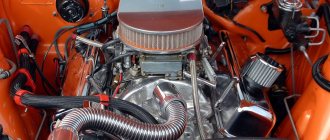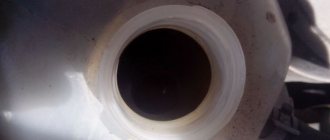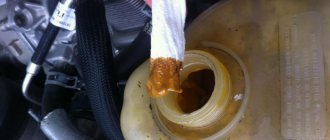Why does antifreeze boil? This situation can arise for a variety of reasons, for example, the cap of the expansion tank of the cooling system has depressurized, the thermostat has malfunctioned, the coolant level has decreased, bad antifreeze has been filled in, the cooling fan or temperature sensor has failed. The main thing that the driver of a car with antifreeze boiling must remember is that further movement is impossible! Failure to comply with this rule can lead to complete engine failure, which can lead to costly and complex repairs. However, eliminating the causes of antifreeze boiling is actually not that difficult, and sometimes even a novice car owner can do it.
VAZ-2114 – the engine gets hot: causes and repairs. Thermostat VAZ-2114
An internal combustion engine is called that because the process of fuel combustion occurs inside its cylinders. In this case, a huge amount of thermal energy is released, which, thanks to the crank mechanism, is converted into mechanical energy. The temperature often exceeds 2000 degrees. No metal, no matter how strong and stable it is, can withstand such a load for long. It is precisely in order to reduce the thermal load and ensure normal temperature conditions for engine operation that the cooling system serves. If it malfunctions, the car’s power unit begins to overheat, as a result of which engine parts expand, lubricant boils, and gaskets burn out. The result of such a destructive process may be failure of the elements of the piston group and the cylinder head. To prevent such an outcome, it is important to know the possible causes of engine overheating and be prepared to eliminate them immediately.
Boiling point of antifreeze
Initially, on the first cars, water was used as a coolant. The boiling point of water is 100 degrees Celsius. The reasons why it was decided to abandon water lay in its low boiling point, which was not designed for heavy loads, and its freezing in winter. After all, when it froze, it turned into ice, and its volume expanded significantly. Such phenomena led to the fact that the cylinder block simply cracked and the entire engine failed, the block of which could only be replaced.
Such disadvantages are absent in antifreeze. The fact is that antifreeze has a certain chemical composition that allows it to withstand fairly low temperatures, which makes it possible for the car to operate normally in winter. In addition, the boiling point of antifreeze is much higher than that of water and is 125 degrees Celsius.
However, such a value as temperature can vary from 108 to 125 degrees. This is due to the chemical composition of the coolant, which, accordingly, changes the boiling point. Changing the composition makes the production of antifreeze more economical, the price for it falls, but at the same time, the boiling point also decreases. Therefore, when buying antifreeze, you should not pay special attention to savings, since the proper cooling of your engine will depend on this.
You should be especially careful with antifreeze with qualitative inconsistencies. Typically, such coolant costs quite little, which is tempting for drivers. However, the boiling point of some specimens is even 85 degrees, which is dangerous for a car engine.
Therefore, be careful and do not buy low-quality coolant. This will save you a lot of nerves and money.
Signs indicating that the engine is overheated
Let's consider how the VAZ-2114 power unit behaves when its operating temperature exceeds the norm. The cooling system of this car is not much different from that of other cars, except perhaps in the simplicity and unreliability of its design. So, when the engine of the “fourteenth” overheats, it lets you know about it with the following signs:
- the arrow of the coolant temperature sensor goes far into the red zone;
- The radiator cooling fan operates in constant mode;
- a specific smell appears in the cabin from boiling antifreeze (antifreeze);
- A cloud of thick, sharp-smelling steam appears from under the hood - evidence of boiling refrigerant.
Preventive measures
To avoid cooling system malfunctions, you need to buy high-quality antifreeze from trusted auto stores and services. If everything worked before replacing the antifreeze, but after the replacement the system boiled, most likely the reason was poor-quality antifreeze.
A sign of fake antifreeze is its boiling over at a temperature on the dashboard of 90 °C. In this case, if the VAZ 2114 boils at 90 degrees, a complete drain of the fake and flushing of the entire cooling system is required.
When purchasing antifreeze, you need to pay attention to both the boiling point and boiling pressure. If the pressure does not match atmospheric pressure, recalculate the temperature. For example, at the promised 135°C-1.2 atm. antifreeze will boil at 100°C-1 atm (if the atmospheric pressure is normal, it will boil at 100°C).
During a daily inspection of the engine compartment with the engine running, you can detect fluid leaks, ruptures in connecting pipes and contamination of the radiator.
To prevent the engine from overheating, you need to set the fan activation temperature on the on-board computer to 95°C (change from the factory setting to 102-105°C).
What to do if you overheat
If, thanks to the listed signs, you understand that your VAZ-2114 engine is heating up more than normal, follow these steps:
- turn off the engine immediately;
- roll the car closer to the side of the road (if you are on the road);
- turn on the ignition and double-check the temperature sensor readings;
- lift the hood, inspect the engine compartment to determine the location of the coolant leak;
- pay attention to the amount of antifreeze (antifreeze) in the expansion tank, but under no circumstances open it while the liquid is hot;
- try to determine the cause of overheating.
In such a situation, it is better to deliver the car to the place of repair (to a service station or garage) by towing, but if this place is located no further than 1-2 km, as a last resort, you can take a risk and get there on your own. Naturally, periodically letting the engine cool down when the sensor needle exceeds 90 degrees.
Antifreeze is boiling, steam is coming from under the hood, what should I do?
The driver pulls off the road, stops, turns off the engine and gets out of the car. He lifts the hood, and there... Antifreeze (antifreeze) is boiling in the expansion tank! What to do in such a situation?
Firstly, under no circumstances should you drive with such a malfunction, otherwise you will have to spend a significant part of the family budget on major repairs of your iron friend.
Secondly, you can try to independently determine the cause of the current situation. As practice shows, there are several reasons that lead to a malfunction in the cooling system.
Thermostat is stuck
A thermostat is a device whose task is to maintain the set temperature of the coolant.
A stuck thermostat looks like this:
In order to verify that it is faulty, you need to warm up the engine, open the hood and find several hoses for the supply and removal of antifreeze. You have found it, now you need to carefully ( the boiling point of antifreeze is 110°C - you can get burned! ) grab both hoses and compare the temperature. Under normal conditions, the supply hose should be noticeably hotter.
If they are both at approximately the same temperature, then the breakdown is really due to a valve stuck in the thermostat, which circulates the liquid only in a small circle and, as a result, does not allow it to cool. In this case, immediate replacement of the thermostat is recommended.
Damage to hoses and leakage of antifreeze
In the same way, you can detect the absence of damage to the antifreeze supply and discharge hoses themselves. In this case, you can slowly and carefully (with stops to cool the liquid) to the nearest service station. With all other options, you should agree with someone to tow it to the nearest service station or auto repair shop.
Loss of coolant properties
Checking the quality of coolant (antifreeze)
The coolant has lost its properties as a result of prolonged use. You can check the liquid using a hydrometer. When replacing, please note that at the moment the manufacturer recommends using antifreeze instead of antifreeze!
Cooling radiator
There are obvious traces of antifreeze leaving, obvious smudges
The next very common reason is the failure of the cooling radiator. This occurs due to clogging of its core with dirt, the appearance of scale on the inner walls of the tubes, or if the liquid circulates very slowly.
It is not uncommon for a radiator to become clogged or leaks to appear due to the use of cooling system sealants.
water pump
The pump is leaking. To find the problem, I had to remove the timing belt cover.
No less common are cases of water pump failure (see “choosing the right pump”). As you can guess from the functional purpose, a problem in the pump may arise with the creation of liquid circulation in the cooling system. And the antifreeze boiling under the hood will be a consequence of this.
Antifreeze level
The location of the coolant reservoir is marked with an arrow
In most cases, the cause of the steam is the driver’s elementary forgetfulness to monitor the antifreeze level, which means that the problem can be solved by simply adding a little coolant.
Burnt antifreeze
Packaging for “scorched” antifreeze (fake). Be careful, don't fall for a fake. The original antifreeze from this company is not bad at all
Reverse side
This happens very often. After replacing the coolant, or after replacing the pump, when part of the antifreeze is drained from the system and a new one is poured. There are a lot of fakes. Symptoms - the temperature on the instrument panel (or in the computer during diagnostics) is no more than 95 degrees, and the antifreeze has already begun to boil away. This means you have filled with “colored” water.
In this case, you will need to completely drain the antifreeze. We have already written about the correct choice of coolant.
Why does the engine on a VAZ-2114 get hot?
Considering that the cooling system of the “fourteenth” is quite simple, it is quite possible to bring it into working condition on your own. But first, let's look at the main reasons for engine overheating. They can be:
- insufficient amount of coolant in the system;
- the liquid pump (pump) is faulty;
- The radiator fan switch sensor has failed;
- blown fan fuse;
- the fan itself is broken;
- the radiator fins are clogged;
- The thermostat has failed;
- The expansion tank plug is faulty.
Let's look at these reasons in more detail.
Insufficient coolant
Do you remember for sure that yesterday the refrigerant level was normal, but today in your VAZ-2114 the engine is heating up and the expansion tank is empty? This means that the tightness of the system was broken. And it’s good if only outside the engine. The worst thing in this case is the burnout of the cylinder head gasket. This malfunction is insidious in that liquid from the channels of the cooling jacket can get inside the cylinders, as well as into the oil channels. Because of this, the engine of the VAZ-2114 often gets hot and the car stalls. The operation of the engine is accompanied by a bluish exhaust with a characteristic odor. Here you will have to remove the cylinder head and flush the lubrication and cooling systems. In the worst case scenario, the engine will need to be overhauled.
More often, coolant leaves the system through the connections between hoses and radiator pipes (cooling and heater), thermostat, expansion tank, and engine. If the engine of a VAZ-2114 heats up and a coolant leak is obvious, check these places first! This problem is solved by tightening the clamps and adding fluid to the cooling system.
Next, inspect the hoses themselves. Often they simply crack over time, and antifreeze or antifreeze, being under pressure, flows out of the system. Such a malfunction can be eliminated by replacing one or another hose.
How to fix the problem?
When the antifreeze boils in the expansion tank and the thermometer needle shows 110 °C or more, you need to turn off the engine and check the following points:
- Try the bottom of the radiator with your hand. If it remains cold, the problem lies in the thermostat. Allow the engine to cool and slowly get to the garage or service station. A faulty thermostat must be replaced; it cannot be repaired.
- Connect an electric fan that does not work on time directly to the battery and continue moving towards a familiar auto electrician who can make an accurate diagnosis.
- It is impossible to determine the degree of radiator clogging without disassembling the system and dismantling the element. Check this version last.
- Jamming and destruction of the pump is accompanied by a sharp jump in the temperature of the antifreeze and leakage of the water pump seal. The part will have to be replaced; driving further is unacceptable.
- The signs of an air lock are identical to the symptoms of a thermostat malfunction. Another thing is that it does not appear out of nowhere: most likely, you unsuccessfully filled the system with antifreeze.
To remove the air lock, remove the hose at the highest point of the system (usually the throttle body) and add fluid to the container until it flows from this pipe.
Now let’s talk about what to do with a faulty expansion tank or radiator cap. The best solution is to replace the defective element; repairs only help for a short time. At the same time, check the condition of the plastic container for cracks that may appear as a result of liquid and steam pressure. Driving with a jammed bypass valve is extremely undesirable.
The gasket between the head and the cylinder block is replaced immediately . A mixture of oil and antifreeze will cause a lot of trouble, including water hammer and destruction of the walls of the combustion chamber in a diesel engine. Please note that gasket failure is not always accompanied by white smoke from the exhaust pipe, so monitor the color and consistency of the coolant in the expansion tank.
If you happen to encounter antifreeze boiling on the road, check the system elements according to the instructions presented above. Three reasons will not allow you to get to the service station under your own power - pump failure, a crack in the cylinder head gasket and complete loss of fluid. In other cases, you can move, making stops to cool the power unit. If antifreeze leaks, temporarily add distilled water to the system.
I replaced the sensor on the ECU. Through the openiag it shows a temperature of 93 degrees and the liquid begins to boil; when you remove the connector, the fan turns on through the openiag too. I don’t know where to drip.
Comments 101
I solved the problem at the spotter by changing antifreeze to antifreeze
It's bullshit about the lid, I specially removed the lid, the fan turns on at 102 degrees, nothing boils, with the lid open!, if everything is working properly, without the lid it shouldn't boil, provided that the liquid is normal
Thank you all for your help, the problem turned out to be the lid, the Luzarovskaya one had a slightly different thread, which is why it didn’t screw on tightly, one VAZ one had a crack, and the other’s valve was very badly eaten by rust, I assembled one lid from them, the Luzarovskaya filling was in the VAZ lid and everything fell into place
If it boils at 93, it means there is no pressure in the system, provided that the temperature seems correct. Change the tank cap.
Liquid pump failure
The role of the pump in the cooling system is to create pressure through which the refrigerant circulates. Its failure can not only cause the VAZ-2114 engine to overheat, but also cause a malfunction of the gas distribution mechanism drive. The fact is that the liquid pump is driven through a gear by a timing belt. Therefore, if the pump fails, it immediately affects the performance of the entire drive. In this case, the fluid pump and possibly the timing belt will need to be replaced.
Consequences of coolant boiling
They can be quite dramatic for a car. Conventionally, there are several degrees of this malfunction, and each of them should be considered separately:
- Slight overheating. If an extreme situation, accompanied by abundant steam, lasted no more than 10 minutes, we can say that the car owner was lucky. The car must be stopped immediately and the engine turned off. There is no need to panic in such a situation: you need to find out the cause and solve the problem. There is no need to undertake immediate repairs of the entire engine.
- Average overheat. It is considered to have occurred if the boiling continued for more than 20 minutes. More serious consequences are possible here. Among them are deformation of the cylinder head (cylinder head), the formation of cracks on it, burnout of the gasket, breakage of the partitions separating the rings on the pistons, and oil leakage through damaged oil seals. This will require thorough engine diagnostics and partial repairs.
With severe overheating, parts and assemblies of the motor begin to sequentially collapse. The problem will affect all systems of the car: there will be a so-called wave that will literally destroy the “insides” of the engine:
- the pistons will begin to melt;
- liquid metal hits the cylinder walls and the piston breaks;
- if the engine does not stall, the oil begins to overheat and lose its lubricating properties, which leads to failure of the rubbing elements;
- molten particles stick to the crankshaft journals, making it difficult to rotate;
- when the valve seats fly out under the influence of dilapidated pistons, the crankshaft simply breaks into pieces, after which the piston can pierce one of the walls of the BC, which will lead to complete destruction of the engine.
Fan sensor malfunction
Failure of the fan switch sensor leads to the fact that during slow driving the radiator does not receive any forced airflow. In other words, the fan simply does not turn on and the liquid does not cool. Checking the sensor is easy. For “fourteeners” with carburetor engines, it is enough to turn on the ignition, disconnect the terminals from the sensor located on the radiator, and short them together. If the fan starts working, the sensor needs to be replaced. If the VAZ-2114 engine (8-valve injector) heats up, with the ignition on, simply remove the terminals from the coolant temperature sensor located on the right of the cylinder block. The electronic control unit will command the engine to operate in emergency mode, and the fan will have to turn on. If this happens, replace the sensor.
But there is one more nuance here - a fuse. If it burns out, the fan, of course, will not turn on. In the mounting block under the hood, find fuse F4 or F8. It is indicated by the corresponding symbol - a propeller. Remove it from the socket and check it with a tester. Replace if necessary.
Faulty thermostat
The VAZ-2114 thermostat is the main element for distributing coolant flows. It is he who regulates the direction of its movement when the engine is cold and when it is warm. The essence of the thermostat is to switch the refrigerant flow from a small to a large circle when it reaches a certain temperature. If it starts to jam, the motor will either take a very long time to warm up, or very quickly.
You can check the VAZ-2114 thermostat in the following way. Start the engine and warm it up to a temperature of 90-95 degrees. Without turning off the ignition, touch the lower radiator hose. If it is warm (hot), then everything is in order: the coolant circulates in a large circle and overheating due to the thermostat is excluded here. If the pipe is cold, get ready to replace this part.
About the operation of the cooling system
Without understanding the operating principle of the cooling system, it is difficult to diagnose the causes of problems and make repairs. The scheme operates according to the following algorithm:
- Until the engine is warmed up, antifreeze (antifreeze) circulates through a small cooling circle, which includes the engine water jacket, heater and thermostat. The fluid level (abbreviated as coolant) in the expansion tank remains within normal limits.
- As the engine heats up, the thermostat opens a large circulation circuit through the main radiator. The antifreeze in the system expands and its excess enters the tank. The increasing pressure is released by the bypass valve of the cover.
- When 95°C is reached, all liquid passes through the main radiator and expands to its maximum volume. The excess is discharged through the additional upper radiator pipe, so it seems that the antifreeze is boiling in the container.
- Cooling of the power unit leads to compression of the coolant to its original volume and a drop in pressure. To prevent vacuum from occurring, the bypass valve of the expansion tank plug allows outside air into the system.
Reference. Some car models provide for 2 discharges of excess antifreeze into the tank - from the radiator and the cabin heater.
Depending on the design of the cooling system, the cap with the valve is installed on the expansion tank or the radiator neck. In the second case, liquid discharge begins after a certain pressure is exceeded, and the tank is constantly connected to the atmosphere through a hole in the plug.
Tank cap
Another cause of overheating may be a plug in the expansion tank. It is designed in such a way as to maintain a certain pressure in the system, which is higher than atmospheric pressure. This is necessary to ensure that the water in the antifreeze or antifreeze does not boil at 100 degrees Celsius. If the plug is faulty and does not hold the required pressure, the coolant may boil prematurely. This will not cause significant overheating of the motor, but may cause problems with the operation of the system.
What is antifreeze and why is it needed in a car?
Refrigerant (antifreeze) has a low freezing point and a high boiling point. The mixture is obtained by combining water and concentrate. Sometimes antifreeze is sold in finished form. In Soviet times, antifreeze was used as a refrigerant. The product was popular among car enthusiasts, but had low quality indicators.
Initially, the motors were cooled with ordinary water, but gradually it had to be abandoned, since in cold weather the water froze, and at excessively high temperatures it quickly boiled. Under such conditions, significant damage was caused to the engine, and this led to additional costs for repairs or replacement of individual parts.
Antifreeze is a more practical composition that can withstand temperatures up to +125 degrees. The substance also does not harden in cold weather. The maximum permissible minus temperature is 40 degrees. Of course, there are also low-quality antifreezes that boil already at +85 degrees.
Such products should be avoided as they can damage the motor and shorten its life. Despite the described qualities, even very expensive and reliable compositions can boil. This is due to various reasons, which I will discuss below.
Cooling radiator
You may ask, what if all the main elements of the cooling system except the fan are working properly, but on the VAZ-2114 the engine heats up when driving, because the oncoming flow of air, even at average speed, can easily replace the propeller? There can only be one reason - the cooling radiator lamellas are clogged. Dirt, dust, leaves, branches, insects - all this settles in layers day after day, not allowing air to blow through the slats.
To prevent this situation, the radiator must be periodically washed with a stream of water to remove contamination.
What not to do when the engine is boiling
There are a number of strict rules that limit the driver’s actions during a situation when antifreeze boils in the radiator, expansion tank or other element of the cooling system. These rules are designed to protect human health from causing serious injury, and to minimize material losses that may arise in the described situation.
- Do not load the engine (do not accelerate, but instead you need to reduce the speed to idle as much as possible, usually around 1000 rpm).
- Do not stop abruptly and turn off the engine, thinking that the engine will stop boiling; on the contrary, everything will only get worse.
- Do not touch hot parts in the engine compartment!
- While steam is coming from under the cap of the expansion tank or other unit and while the antifreeze is bubbling in the system, you should absolutely not open the cap of the expansion tank! This can only be done after the time specified above has passed.
- Do not pour cold water on the engine! You need to wait for the engine to cool down on its own.
- After the engine has cooled down and new antifreeze has been added, you should not drive after the temperature reaches more than +90 degrees.
Compliance with these simple rules will ensure the safety of the driver, and also minimize the degree of breakdown and, consequently, possible material costs.

